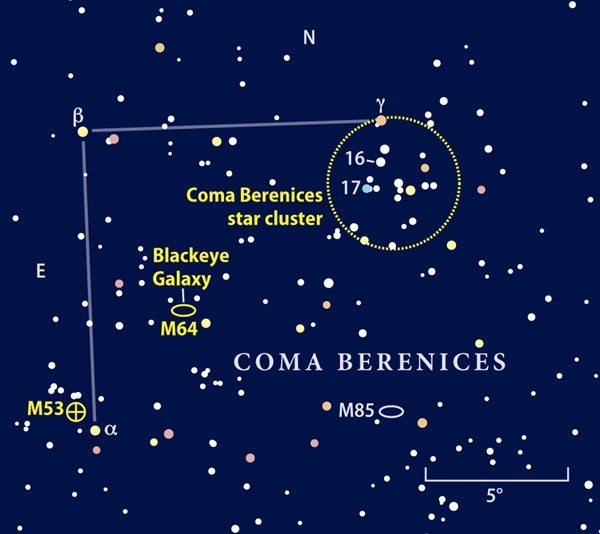One of the reasons I’m so keen to observe the April sky is the Coma Berenices star cluster (Melotte 111), which is among my favorite binocular targets. To find the cluster in its namesake constellation, Coma Berenices (Bernice’s Hair), aim toward the center of the large “empty” area framed by the constellations Boötes the Herdsman to the east, Leo the Lion to the west, and the arc of the Big Dipper’s handle to the north. Scan back and forth slowly until you bump into a wedge-shaped group of stars that will nearly fill the field of your binoculars. That’s the Coma star cluster. In fact, if you view from a dark site, you can see the Coma star cluster as a fuzzy patch of light without using any optical aid.
That misty appearance quickly dissolves into myriad points of distant starlight through even the smallest binoculars. The brightest stars fall into a pattern resembling the Greek letter Lambda (λ) (if you’re viewing from south of the equator, Gamma [γ]).
Once you find the cluster, sit back and examine it carefully. You might notice that the star at the Lambda’s northern tip, 4th-magnitude Gamma (γ) Comae, has an orangish glow. Gamma is a spectral type K orange giant star that is just starting to evolve off the main sequence. Knowing the spectral classes of these stars allows astronomers to estimate the age of clusters. In this case, scientists estimate the Coma cluster to be only about 400 million years old.
Follow the eastern side of the Lambda southward to 16 Comae. Binoculars show three faint companions surrounding it, standing at attention as if guarding a precious jewel.
Farther southeast, the binary star 17 Comae is easy to resolve through binoculars. This pair of white-hot stars appears separated by more than 2′, which is wide enough to resolve even through modest 6x field glasses.
Continue westward to 4th-magnitude Alpha Comae. M53 is less than 1° northeast of Alpha. Look for a round, hazy disk, like a small interstellar ball of cotton set in a star field.
Coma Berenices probably is best known for its wealth of distant galaxies. Unfortunately, most are beyond the grasp of binoculars. One that stands out from the rest, however, is M64, the famous Blackeye Galaxy.
To find it, slide about half a field of view due west of Alpha Comae to the reddish star 36 Comae, and then move northwest to 35 Comae. M64 is just to 35 Comae’s northeast. With 50mm binoculars, you may glimpse this 8th-magnitude galaxy as an oval patch of light.
Viewing through 20×80 or larger binoculars, you also might spot the “black eye,” a dark lane of dust clouds silhouetted in front of one of the Blackeye Galaxy’s spiral arms. Interestingly, this lane seems to mark a boundary separating two counter-rotating sections of the galaxy. Studies suggest that this bizarre situation is the aftermath of a collision between a small galaxy and a large galaxy that is still settling down.
Subscribers, join me on Astronomy.com this month for a few other binocular targets in and around Coma Berenices, as well as a link to a free binocular observing guide.
Questions, comments, suggestions? E-mail me at phil@philharrington.net. Until next month, when we head to the deep south, remember that two eyes are better than one!
All around Coma Berenices.
March 2009: Messier madness
See an archive of Phil Harrington’s binocular universe











